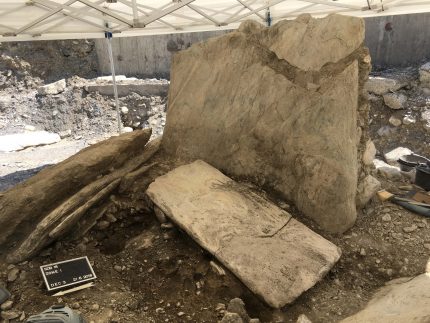Archaeologists have unearthed a 3,000-year-old dolmen during construction of an underground car park in Sion, southwestern Switzerland. The parking deck was being built at the late Bronze Age, early Iron Age necropolis of Don Bosco as the excavation of the last graves was coming to a close. The dolmen long predates the necropolis.
Sion is of the richest prehistoric sites in Europe with the earliest evidence of settlement going back to 6200 B.C. Early farmers arrived around 5800 B.C. but settlement really started taking off in the middle Neolithic, ca. 4500 B.C. That’s when burials in stone cists began. Those individual tombs gave way in the 3rd millennium B.C. to large communal tombs erected out of dry stone slabs with engraved stele, ie, dolmens. The stone vaults could contain more than a hundred individuals.
This dolmen was found in parts with only one slab in its original position. Located on the alluvial plains of the Sionne, a tributary of the Rhone, the dolmen’s slabs were likely shifted by river floods and currents. They smallest of them weigh several tons. Similar stone slabs have been found dotting the perimeter of the construction site, so it’s likely there was more than one dolmen there.
The find site will be excavated further in the hope of finding human bones still inside the associated burial chamber. It’s a slim hope given the river floods which were powerful enough to dislodge heavy stone slabs. Archaeologists will also look for dateable material to pinpoint the age of the dolmen and later findings from the Celtic necropolis.
The stones will be recovered, cleaned and conserved. Experts will examine them with a variety of imaging techniques, raking light, laser scanning, etc. to determine whether any of the slabs are engraved.
